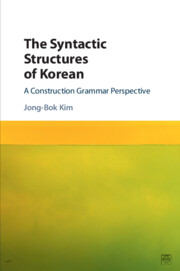Book contents
- Frontmatter
- Contents
- Acknowledgments
- Abbreviations
- 1 Theoretical foundations
- 2 Noun phrases
- 3 Case system
- 4 Auxiliary and complex predicate constructions
- 5 Gerund phrases and mixed categories
- 6 Verbal nouns and light verb constructions
- 7 Serial verb constructions
- 8 Negation and related phenomena
- 9 Coordination
- 10 Passive constructions
- 11 Wh-questions
- 12 Topic and focus constructions
- 13 Relative clause constructions
- 14 Honorification
- References
- Index
14 - Honorification
Published online by Cambridge University Press: 05 July 2016
- Frontmatter
- Contents
- Acknowledgments
- Abbreviations
- 1 Theoretical foundations
- 2 Noun phrases
- 3 Case system
- 4 Auxiliary and complex predicate constructions
- 5 Gerund phrases and mixed categories
- 6 Verbal nouns and light verb constructions
- 7 Serial verb constructions
- 8 Negation and related phenomena
- 9 Coordination
- 10 Passive constructions
- 11 Wh-questions
- 12 Topic and focus constructions
- 13 Relative clause constructions
- 14 Honorification
- References
- Index
Summary
Honorific agreement is one of the main properties in languages like Korean, playing a pivotal role in appropriate communication. This makes the deep processing of honorific information crucial in various computational applications such as spoken language translation and generation. We argue that, contrary to the previous literature, an adequate analysis of Korean honorification involves a system that has access not only to morphosyntax but to semantics and pragmatics as well. Along these lines, this chapter offers a constraint-based HPSG analysis of Korean honorification.
Basic properties of honorific agreement
Subject agreement
Honorification, one of the main features of spoken language in Korean, plays a key role in proper and successful verbal communication (Chang 1996, Sohn 1999, Kim and Sells 2008b, Kim 2011). The Korean honorific system basically requires that when the subject is in the honorific form (usually with the marker -nim), the predicate also be inflected with the honorific form -(u)si, as in (1a):
(1) a. sensayng-nim-i wus-usi-ess-e
teacher-HON-NOM smile-HON-PST-DECL
‘The teacher smiled.’
b. #sensayng-nim-i wus-ess-e
teacher-HON-NOM smile-PST-DECL
‘The teacher smiled.’
Examples like (1a) are most natural in the sense that the subject agrees with the matrix verb in terms of honorification. However, those like (1b), where there is disagreement between the two, may be used when the speaker does not honor the referent of the subject (marked by #).
Considering that agreement disconcord can be used in a limited context, one may assume honorific agreement in Korean is purely pragmatic. This pragmatic direction has led literature to assume that using the -nim and -si form of verbs is a matter of gradience and appropriateness rather than grammaticality (see, among others, Pollard and Sag 1994, Chang 1996, Lee and Ramsey 2000, Aarts 2007). However, one key property that has often been ignored is that honorific agreement must be observed when the subject is non-human, as illustrated by the examples in (2) (Sohn 1999, Kim 2011):
(2) a. cha-ka o-(*si)-ess-e
cha-NOM come-HON-PST-DECL
‘The car came.’
b. kwukhoy-ka ku pepan-ul simuy-ha-(*si)-ess-e
congress-NOM the bill-ACC review-do-HON-PST-DECL
‘The congress reviewed the bill.’
If we rely only on pragmatic information, we would have difficulties understanding why, unlike the disagreement data in (1b), disagreement cases like (2) are hardly found in real language usages.
- Type
- Chapter
- Information
- The Syntactic Structures of KoreanA Construction Grammar Perspective, pp. 318 - 332Publisher: Cambridge University PressPrint publication year: 2016

